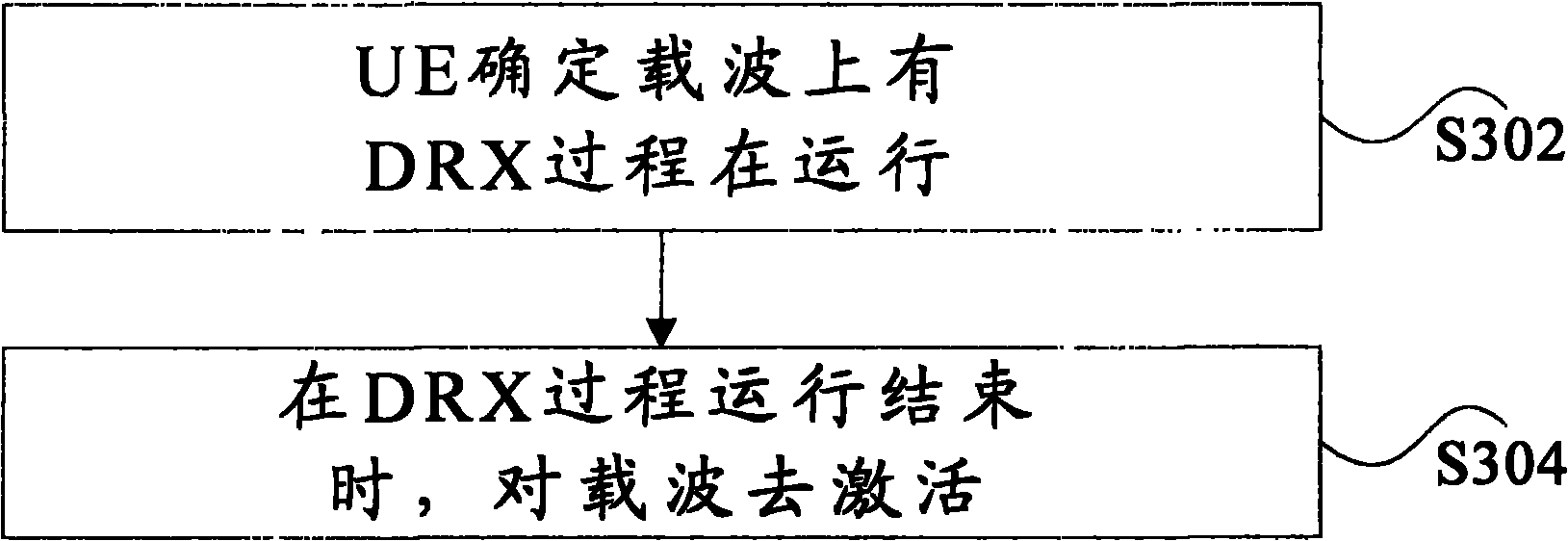Processing method of carrier wave deactivation and user equipment (UE)
A technology of user equipment and processing method, which is applied in the field of communication, can solve problems such as data transmission loss and failure to receive a successful response from the base station, and achieve the effect of ensuring data transmission
- Summary
- Abstract
- Description
- Claims
- Application Information
AI Technical Summary
Problems solved by technology
Method used
Image
Examples
Embodiment 1
[0085] This preferred embodiment 1 describes the process of deactivating the carrier to the running "short DRX process".
[0086] In related technologies, the purpose of introducing the short DRX process is that within a period of time after data transmission or under the expectation of the base station, it is more likely that subsequent data transmission will be required, and the UE will continue to stay in the short DRX process to prepare for timely Once the short DRX process is triggered, its duration is determined by the drxShortCycleTimer timer.
[0087] The start of the short DRX process is triggered by an aperiodic process, that is, the drx-InactivityTimer times out or the DRX Command sent by the base station is received. The short DRX procedure can be set as a carrier-specific procedure or a UE-specific procedure. The so-called carrier-specific process means that the UE maintains a drxShortCycleTimer timer for each activated carrier, the short DRX process is triggered...
Embodiment 2
[0095] The second preferred embodiment describes the process of deactivating the carrier to the running "activity detection process".
[0096]In carrier aggregation, UE can work on up to 5 downlink carriers. The "activity detection process" can be set as a carrier-specific process or a UE-specific process. The so-called carrier-specific process means that the UE maintains a drx-InactivityTimer timer for each activated carrier, and receives the first uplink or downlink transmission scheduled by PDCCH on the activated carrier, and the UE starts or restarts the corresponding drx-InactivityTimer timer on the carrier ; The so-called UE-specific process means that a UE only maintains a drx-InactivityTimer timer, and any active carrier receives the first uplink or downlink transmission scheduled by the PDCCH, and the UE starts or restarts the timer.
[0097] In this preferred embodiment, when the carrier is deactivated, the UE performs corresponding processing according to the chara...
Embodiment 3
[0104] The third preferred embodiment describes the process of deactivating the carrier to the running "downlink waiting for retransmission process".
[0105] The "downlink waiting for retransmission process" is implemented based on the HARQ rule. After receiving the downlink data scheduling, the UE will start an RTT timer for the HARQ process that received the downlink data. If the UE does not perform the received data before the RTT timer expires If the decoding is successful, a drx-RetransmissionTimer will be started for the HARQ process after the RTT timer expires to ensure that the UE is always in the active time state during the retransmission process.
[0106] In this preferred embodiment, when the carrier is deactivated, the UE performs corresponding processing on the running "downlink waiting for retransmission process" according to different deactivation modes.
[0107] method one
[0108] If the base station deactivates the carrier through display signaling, becaus...
PUM
 Login to View More
Login to View More Abstract
Description
Claims
Application Information
 Login to View More
Login to View More - R&D
- Intellectual Property
- Life Sciences
- Materials
- Tech Scout
- Unparalleled Data Quality
- Higher Quality Content
- 60% Fewer Hallucinations
Browse by: Latest US Patents, China's latest patents, Technical Efficacy Thesaurus, Application Domain, Technology Topic, Popular Technical Reports.
© 2025 PatSnap. All rights reserved.Legal|Privacy policy|Modern Slavery Act Transparency Statement|Sitemap|About US| Contact US: help@patsnap.com



